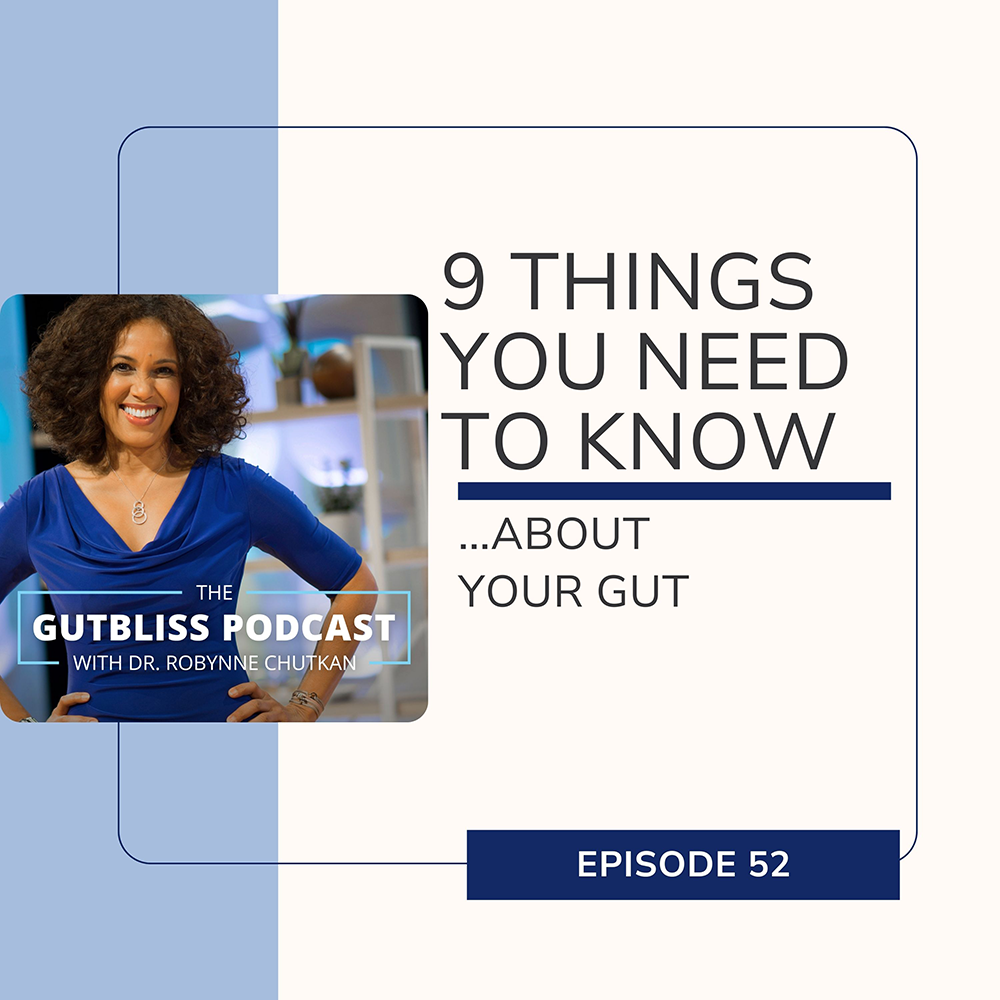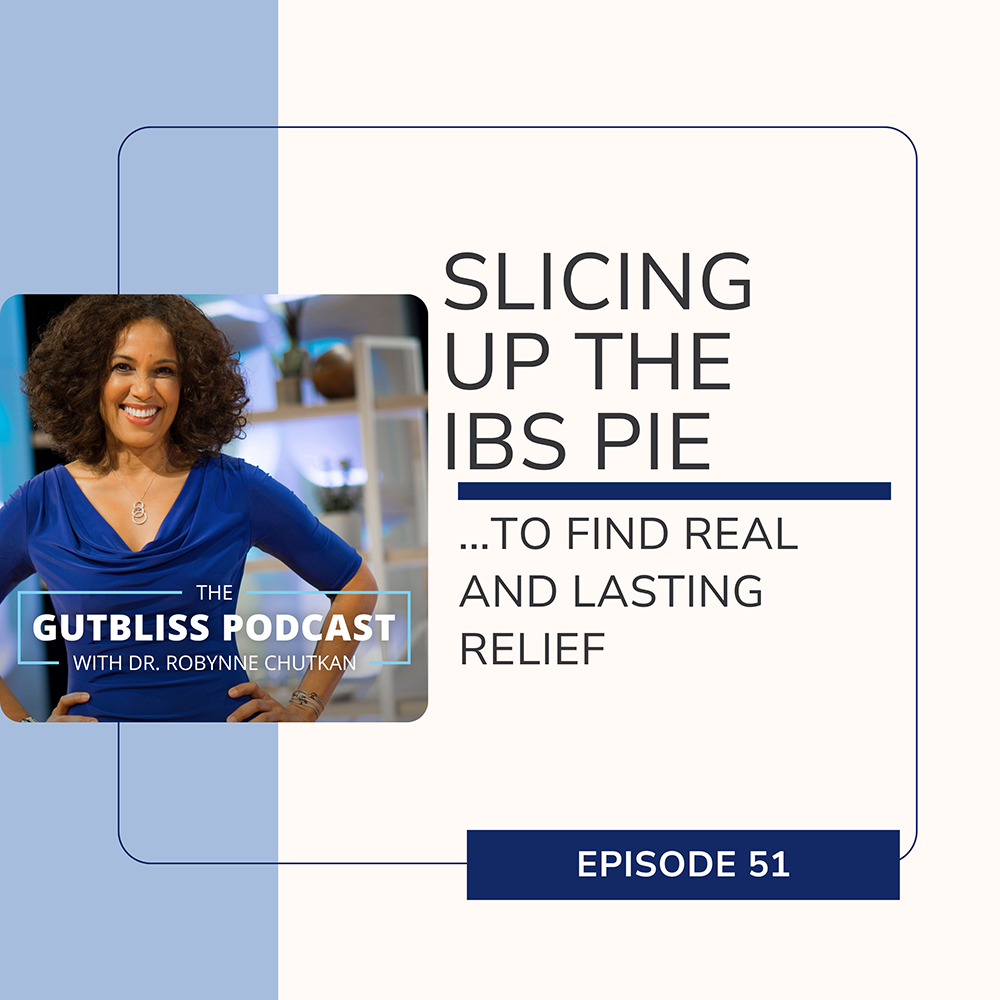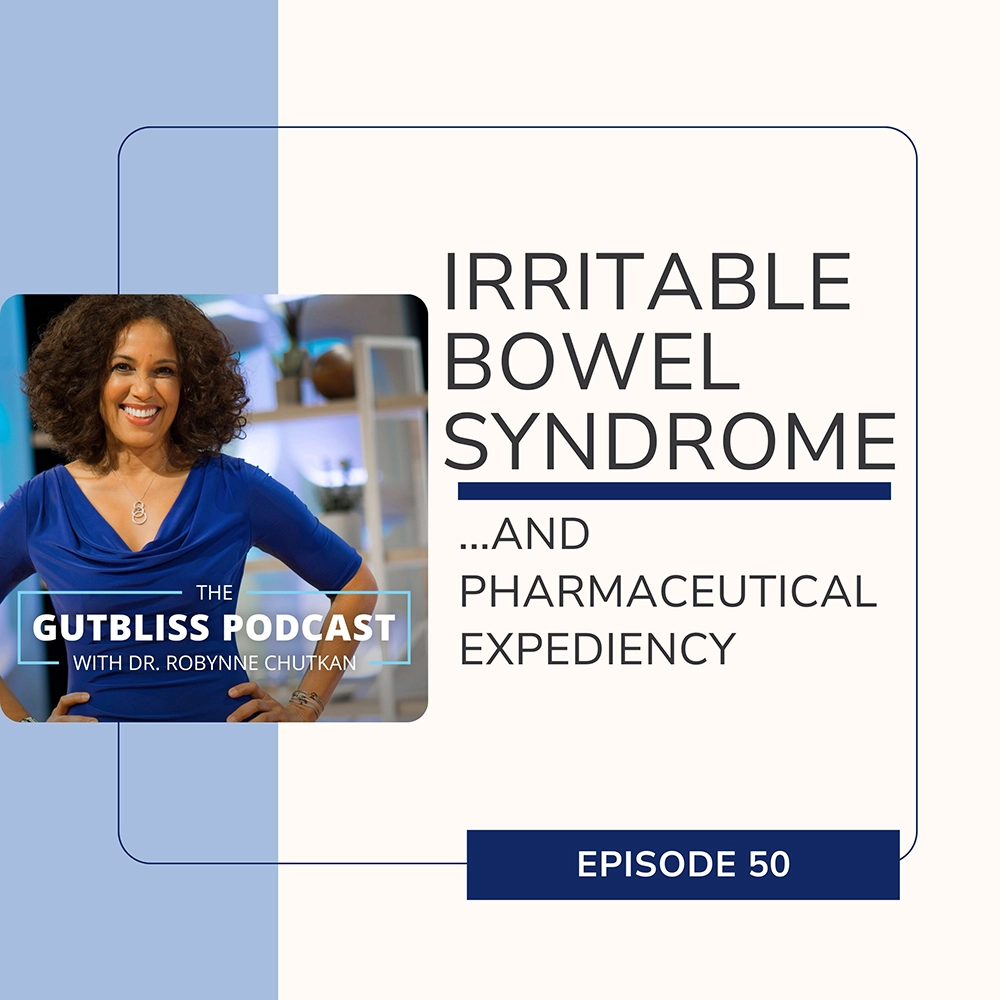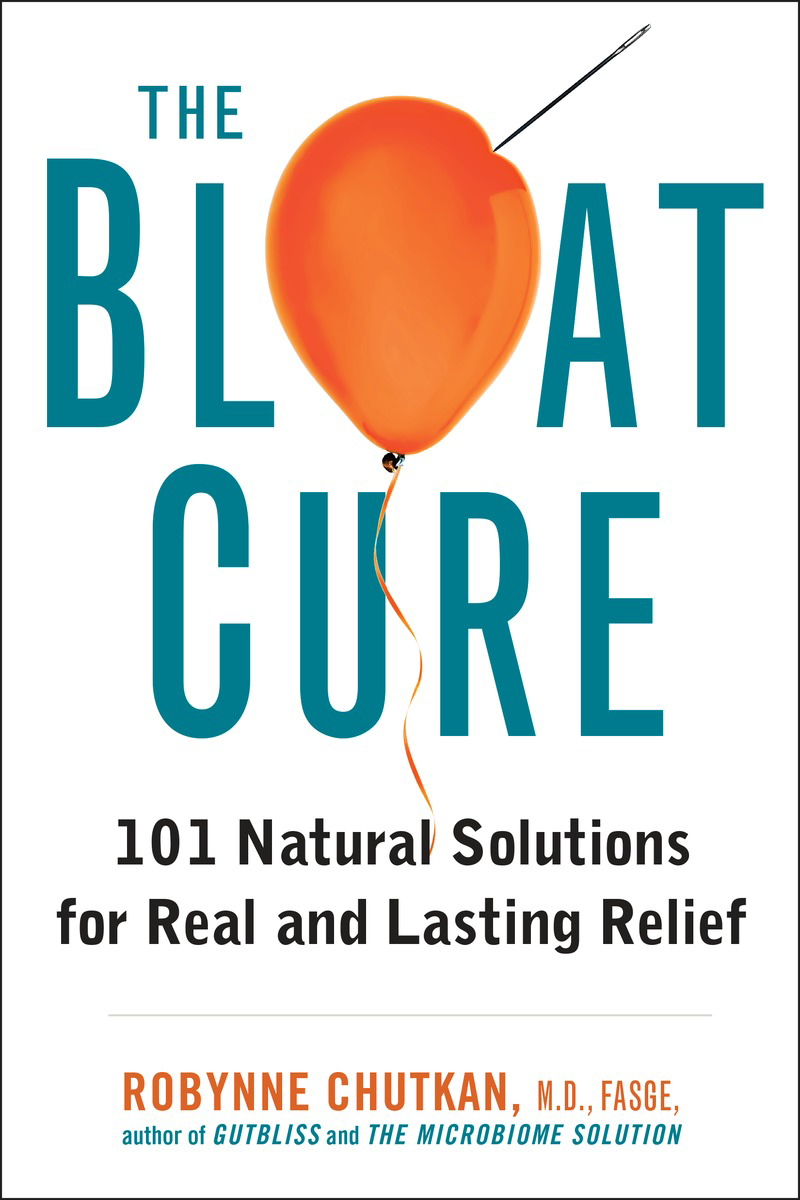Feelings of stress and anxiety aren’t just in your head; they’re also in your body, especially in your GI tract, and they can cause or worsen almost every digestive condition. Like many people, you may have a lot of stress in your life, and you may also have been diagnosed with irritable bowel syndrome, but could stress actually be causing or contributing to your irritable bowel syndrome? The answer is yes! In this episode, I’m going to give you some simple but effective tools for how to quiet your mind – and your GI symptoms.
Thank you for being a part of our community! For the latest in digestive wellness go to https://gutbliss.com/ and follow us on Instagram for more gut health info.
On today’s show, I want to tell you about a cardiologist named Herbert Benson. In 1975, Dr. Benson wrote a book called The Relaxation Response, a simple observation, which was that blood pressure was higher in the doctor’s office than when patients measured it themselves at home. And this simple observation caused him to speculate that there may be a connection between stress and high blood pressure. Now, I know this may seem very basic and rudimentary to you now, 50 years later, but in 1975, this was a completely new idea. Dr. Benson was ridiculed by his colleagues, but he took his theory to the lab, and he taught monkeys how to control their blood pressure with a reward system that used colored lights, and he was eventually able to train the monkeys to lower their blood pressure using just their mind when the appropriate lights were turned on. Next, he turned to transcendental meditation, and he was ultimately able to prove that meditation alone could lead to dramatic changes in heart rate, in metabolic rate, in breathing rate, and that people who practice meditation had much lower blood pressure, so that this was actually a super useful tool for controlling blood pressure. Now, of course, practitioners of Eastern medicine had known about these techniques and had used them in their practices for thousands of years, but Dr. Benson’s results were groundbreaking in Western medicine. His theory introduced this idea that the mind and the body were connected. They weren’t separate systems that functioned independently.
It’s obvious to most of us that our brain is connected to the rest of our body. If I decide to go for a run or to pick up the phone, my brain has to send a message to the appropriate muscles, to my legs or to my arm to pick up the phone for the activity to be carried out. And that’s easy to understand when we’re talking about actionable things like moving our hands and feet. But what about how your body responds to emotions? The example I like to use when I am trying to illustrate that what is in your head is also in your body is you’re walking through the woods and a bear jumps out at you. How do you respond? Your adrenal glands send hormones coursing through your body, hormones like adrenaline and cortisol, and these are mediators of the fight or flight response that provide you with quick bursts of energy to face down the bear or to run for cover. These hormones cause a cascade of changes in your body that occur almost immediately. What kind of changes? Your heart rate increases, you start to breathe fast, you get sweaty, the hair on your body stands on end, your blood pressure goes up, your pupils dilate, all kinds of changes. And in keeping with Dr. Benson’s theories, we know that emotions like fear and stress result in real and measurable changes. These feelings are not just in your mind, they are also very much in your body, especially in your gut. When we come back, more on how you can harness that physiological and hormonal connection between your mind and your gut to manage IBS symptoms when we come back.
The Gutbliss Podcast is brought to you by Visbiome, my first and quite frankly, my only choice for a probiotic. Whether you’re dealing with irritable bowel syndrome or just looking to restore your gut health, Visbiome can help. It’s a medical food for the dietary management of IBS and gut inflammation. Backed by science and clinically vetted by thousands of my own patients. Find your gut bliss with Visbiome. Go to Visbiome.com/gutbliss and use discount code GUTBLISS at checkout.
Our fight-or-flight response has evolved to help us survive. So in times of stress or threat, it diverts resources from other systems, like our digestive system, so that all of our energy and all of our attention can be focused on managing the stressful thing that is about to happen, like the bear is about to attack us. And then once the danger passes, the relaxation response kicks in, allowing everything to get back to a normal, mellow state. But the problem that so many of us are experiencing is that our modern lives are not normal and mellow. They are just the opposite. We are in a constant state of “the bear is about to attack us”, in a state of agitation, especially if we’re watching or listening to the news. And our body experiences this as a continuum of one stressor after another, whether it is you’re late to pick your kid up, you have a deadline at work, you don’t know what you’re cooking for dinner, whatever it is, being in this chronic fight or flight, stressed out state can have devastating effects on your body. It impairs your ability to think clearly, it decreases your thyroid function, it affects your immunity, your bone density, I already talked about it increasing your blood pressure, but it also increases blood sugar, putting you at risk for diabetes, and it causes inflammation in your body.
Like many people, you may have a lot of stress in your life, and you may also have been diagnosed with irritable bowel syndrome, but could stress actually be causing or contributing to your irritable bowel syndrome? The answer is yes. There are people with IBS whose symptoms are entirely due to stress, but more commonly stress is an exacerbating factor. It makes the IBS symptoms worse. And stress doesn’t just contribute to IBS. It’s a hugely important aspect of pretty much every chronic disease, including cancer and arthritis and gout and heart disease and diabetes and many, many other autoimmune diseases, especially. Stress really wreaks havoc in your digestive system though. It does all kinds of problematic things there. It increases your stomach acid production, which can cause heartburn and nausea. It shunts blood away from your intestines, which interferes with digestion and absorption of nutrients, and it decreases enzyme secretion, so it’s harder to digest food. It slows down stomach emptying, so it can cause again nausea and reflux and just a feeling of fullness, and it speeds up colonic contractions, which can lead to diarrhea.
You may have had the sensation of butterflies in your stomach or nausea or feeling like you have to poo right before a big event. Those are all gut manifestations of stress. Treatments like gut-directed hypnotherapy and cognitive behavioral therapy to leave stress have both been found to be really effective therapies for IBS in lots of different clinical studies. And in many of those studies, superior to medical treatment alone, they’ve shown improvement in quality of life outcomes and long-term positive effects. CBT, cognitive behavioral therapy, works by identifying and modifying negative thoughts and beliefs associated with IBS symptoms. And it teaches you coping mechanisms like relaxation techniques and behavioral strategies to manage the stress and anxiety that can exacerbate your IBS symptoms. A gut directed hypnotherapy approach uses hypnosis to directly target the gut brain connection. And it often incorporates imagery and suggestions to help people perceive and respond differently to the gut sensations they’re experiencing and to reduce their sensitivity to discomfort. When we come back, we are fortunate to have my good friend and colleague, Janet Jumper, nurse practitioner in the Gutbliss Studio. And she is going to be talking about some of the practical tools that you can use every day on your own, without special equipment, without a therapist or practitioner to help you manage your GI symptoms, IBS symptoms, autoimmune symptoms, whichever type of gut symptoms you are having when we come back.
We are back talking about a mind-body approach to managing GI symptoms. And we’re so lucky to have Janet Jumper, nurse practitioner, back with us. Janet, welcome.
Thank you. I want to talk with you today about actionable items for managing stress in the setting of any illness. And it takes me back to a time when I was in your office long, long ago, and you were talking to me about stress and IBD. And as you know, I have Crohn’s, and the audience knows I have Crohn’s. And I had never really made that association. And I was in a stressful job running around as a nurse and nurse practitioner. And all of a sudden, you gave a reference to a snake, I think earlier you talked about a bear. And that really spoke to me. And I’ve thought about it a lot, but it’s only in the last three to five years that I’ve really put that into practice. So I want to talk about some easy things that I do. The first intervention that I do, and there’s a lot of information out there about it, is breathing. But I wanted to talk a little bit, because when you go to think about breathing, you think, well, should I be doing it this way? Should I be doing it that way? I get really caught up myself in the execution of the plan. So I just want to give the listeners one way to do it that they can try. Maybe it will stimulate them to think of another way. But in the meantime, they can try my way and see if it works.
And for folks out there listening, I know some of you may be thinking there’s no way that just breathing can help my GI symptoms. I have serious GI symptoms. Let me point out to you that there are published scientific studies showing that these therapies are often superior to medication alone. So if you think, oh, it’s just too simple, just give it a try, give it a try. Okay, so Janet, tell us how to do this.
Yes, so in a comfortable position, either lying or both feet on the floor, one hand on your belly, one hand on your heart. And you’re going to start by taking a couple of deep breaths in and out. And the first that you’re going to do are belly breaths. So you’re going to try to keep your hand on your chest still, and you’re going to expand your belly out. And you’re going to do two deep and slow breaths that way. The next two breaths you’re going to do are again keeping your chest from rising and you’re going to expand your side ribs. So you’re going to try to breathe into your side ribs. You’re going to do two breaths that way. The next two breaths again hand on your chest, hand on your belly, keep your chest from expanding. You’re going to breathe two breaths into your back body. Try to get your thoracic spine to move backward. And then you’re going to end with two more belly breaths, again, trying to keep your chest from rising, and you try to expand your belly out. And that’s eight total breaths, and you should do them slowly, and it takes about a minute.
I know a lot of breathwork experts talk about the ratio of the inhalation to the exhalation. Does it really matter? Does exhalation need to be longer, shorter? What are your thoughts?
So this is where I think getting caught up in the execution of the plan prevents you from starting the plan. So just try it and see what you think. Don’t worry about counting in, counting out, and just see where you get. And then if you get to a place where you’d like to do a count of four for an inhale and a count of eight for an exhale, you can get to that part. But let’s not start start there. Let’s start simple.
I love it. And if you want to start even simpler, my sort of basic intro method to this for patients is I tell people lie on your back, do exactly as Janet says, one hand on your chest, one hand on your belly, but put a bag of rice on your belly so that you can really see something move and just do eight belly breaths. And what that means is that every time you inhale, your belly, aka the bag of rice on your belly should be rising. And when you exhale, it should fall. So that’s how you know you’re breathing into your belly. When you see your belly rise with a bag of rice on it, that’s like super, super simple way. So if you want to start with something even simpler, and then work your way up. But as Janet said, don’t get caught up whether you have a bag of rice or not, if the belly is expanding a lot or not, what part of the body is moving. The idea is you want to keep your chest still though and breathe into your belly.
That is true. And I don’t have studies to quote, but I’ve been listening to a lot of content out there that talks about even how placing your hand on your heart, just the act of that, and placing your hand on your belly, just the act of that, actually does refocus your mind to those places and sends neurotransmitters out that are relaxing and calming. So just thinking about that when you’re doing this action could start you off in a really good way.
I love that you mentioned that, and I want to give a shout out to my favorite yoga place of all time which is Down Dog Yoga here in Washington DC. My husband and I were at yoga yesterday and I hadn’t been moving much the last week because I was recovering from a cold and we went and the wonderful instructor Christina made some adjustments that involved her placing her hand on my hips on different parts of my body. And afterwards, my husband said to me, you always end up with people touching you during yoga. And I said, well, first of all, it’s called an adjustment. Nobody’s feeling me up during yoga, let’s be clear. It’s called an adjustment. And I said, yes, I said, you know, I really love it. And I think that, I mean, I’ve been coming to Down Dog Yoga a long time. So I know the instructors, and I think people tend to make adjustments to people who are more receptive to it, right? Nobody wants to be adjusting somebody who maybe they don’t know as well, maybe isn’t as receptive to it. So I feel like I just emanate, touch me, adjust me. And her hand on my body is so therapeutic. I mean, beyond the adjustment she’s making of alignment, I feel really comforted and calmed by it.
Maybe this is an anthem to our yoga instructors because my yoga instructor, Maria, who I love and adore, in Shavasana, she’ll come and place a blanket or move your headrest and tuck it underneath you and lay the blanket and tuck it under you. And same, I mean, her touch in that just supportive and therapeutic way is so calming and lovely.
So thank you to all our- Yes, Christina and Maria is your person. Yeah, thank you. You bring us so much joy, we love you. But therapeutic touch, I love the message you’re giving, which is, it’s also what you can do for yourself of putting that hand on the chest. And so often in healthcare, we are looking for a complicated, high-tech answer. I remember sitting in my office so many times and people would come to see me and I would be sitting there thinking, how can I make eat more vegetables, breathe, drink water, sound sexier and more complicated and medical? But if you listen to me, you know that I am all about a foundational approach to gut health. And that’s what Gutbliss is. It really is the basics. And this is as basic as they come. And at the top of the episode, I gave you all the information about Herbert Benson and the relaxation response. Great book, by the way, to pick up. Small little book, you can read it in a day. But the theory of that and how that has trickled back into the literature. And now we’re seeing the clinical studies that validate it and so on. But in some ways we’ve always known this, right? We’ve just sort of gotten away from it. And so we’re encouraging you to come back to it. Janet, what else? I love the breath. And again, follow Janet’s advice, don’t get caught up in the execution, eight breaths and then move on with the rest of your day. And if you have time, come back to it. But what else do you recommend?
So this is a little, slightly more complex than the breathing. It takes a little bit more time, but definitely worth it. I have found a lot of value in guided imagery. I went to a workshop by Belleruth Naparstek, and I really enjoyed her mostly, one, for the way that she speaks and the images that she provides, but also she did studies on PTSD survivors from Afghanistan and Iraq at Walter Reed Medical Center at the time, that was what it was called. And I really enjoyed hearing the outcomes that those patients had with her guided imagery and that was for treating PTSD. So I brought that information back to sort of how can I manage my own stress. And I think that her guided imagery is phenomenal, and I use it in lots of different ways. But the thing that I think that’s really great about it is it’s actionable, it’s 20 minutes, it’s downloadable on the internet or if you want to pay for an app subscription, you can. And I particularly like her voice and her style. So I would recommend her as a starting point, just so you get an idea of what is available, because there’s so much content out there. I feel like some of it could potentially be not as valuable as what she does or what she did for me.
And the link will be in the show notes, but for those who didn’t catch the name, her name is Belleruth Naparstek and she has different styles for whatever you’re navigating, and they’re pretty short. She also does affirmations which you can do in the car those you don’t need to be sort of in a relaxed or eyes closed State so what I will do in my house is I will go upstairs. I will lie down on my bed I will put a heating pad on my abdomen and I will turn on the app and I’ll do a 20 minute affirmation and I try to be kind to myself. If I fall asleep in the middle of it, if my mind drifts off, I bring my thoughts back, but I listen to it and she does for her guided imagery. She’ll sort of take you on a journey in the imagery that’s very, I don’t know, loving and warm and I feel like it’s a stress reliever. So what, what kind of imagery is it sort of like imagine yourself in a field or looking at a river? So one of the ones that I really love that she does is she talks about your inner advisor and she talks about this person that you love and trust and you can envision whoever or whatever you want. It could even be a pet. And one of them you interact with this inner advisor and they talk to you and they listen to your thoughts and feelings. And I don’t know, I can’t really describe like what it is. You have to listen, but it’s very calm and comforting and I’m doing another one about trauma that talks about journeying into your own heart. But I’m a big words person and the words that she uses and the imagery that she conjures up for me is really lovely and so I’ve found it to be a great healer and stress reducer for me.
So if you’re not as interested in using the app or doing it with the assistance of someone else, one way to do it is just to think about something that feels calming and joyful to you. It may be a family memory, it may be a vacation, it may be a food, whatever it is, and to focus on that thing. And if you want to learn more about the mind-gut connection, I highly recommend my friend, Dr. Emeran Mayer’s book called, The Mind Gut Connection. He is a neurogastroenterologist who worked at UCLA for a long time. He’s a lovely person and his book is fantastic, The Mind Gut Connection. So check that out if you want to go a bit deeper into some of these relationships between what is going on in our mind and what is going on in our gut. I want to thank Janet again. Love when you’re here. Thank you so much for being with us. And I want to leave you with three takeaways about the mind-gut connection:
1. What’s in your mind is also in your body, especially in your gut.
2. Techniques like deep breathing and guided imagery can help improve mental of stress and anxiety and also improve GI symptoms like nausea and abdominal pain, and even motility disturbances that can lead to constipation and diarrhea.
3. A licensed hypnotherapist or cognitive behavioral therapist can be really helpful, but you can get started on your own with just eight deep belly breaths, simple affirmations, or focusing your mind on a calming thought. Start small and simple and build from there.
So that’s it for this week’s episode of the Gutbliss podcast on the mind gut connection. So that’s it for this week’s episode of the Gutbliss Podcast on the Mind Gut connection. Coming up next week, the three most important causes of acid reflux – and how to get rid of them without blocking your stomach acid.









